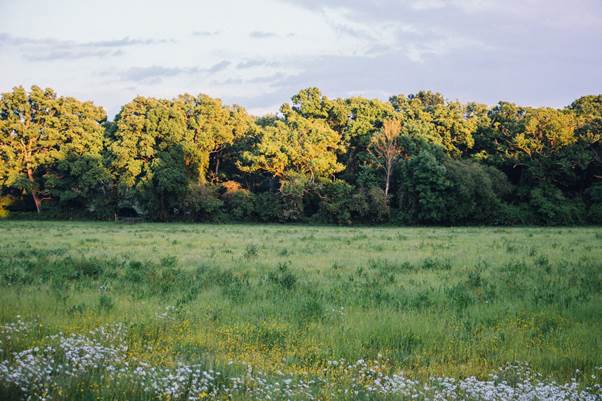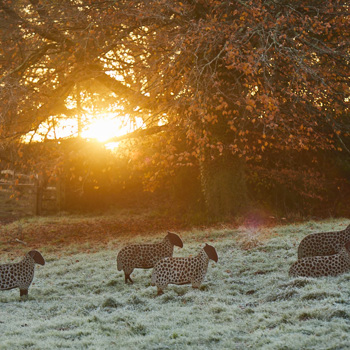At Lime Wood, nature is not just a backdrop, it's a way of life. This summer, we’re delighted to share a piece from our resident forager, Sammie, who takes us on a wander through one of Lime Wood’s most breathtaking features: our wildflower meadow. Rich with colour, scent, and stories, it’s more than just a pretty view, it’s a treasure trove for wildlife and curious foragers alike.
_________________
There is beauty in each of the seasons at Lime Wood. However, as you arrive up the driveway in early summer, there is nothing quite like the sight of the wildflower meadow in full bloom. Sadly, grasslands and meadows are some of the most threatened and depleted ecosystems in the UK, and with them, all the species of flora and fauna that flourish there. Because of this, I avoid harvesting much from this habitat, being either very sparing or simply enjoying their beauty.
I must begin with an inedible species found at Lime Wood that I simply couldn’t overlook due to its breathtaking beauty and rarity: wild orchids. Last summer, I was lucky enough to find an Early Spotted Orchid and a Pyramidal Orchid in the meadow. Both have cones of purple or pink blooms that look impossibly exotic for the UK. They belong to an ancient family of flora and are beloved by pollinators. Their presence here only further confirms the vital work of habitat restoration in places like this.
Another star of the show is the Oxeye Daisy (Leucanthemum vulgare). I adore this edible flower. It is gloriously joyful and steeped in old folklore. The "daisy" in its name refers to its old name, day's eye. The smaller Common Daisy (Bellis perennis), to whom the Oxeye is related, opens and closes with the sun. “Ox-eyed” was a medieval compliment meaning eternally bright, indicating that this flower remains open constantly, giving it its other folk name: Penny Moon Daisy. Growing up to a metre in height, it shares the same benefits as its little sister. The spoon-shaped leaves and large white flowers can be used in salads or cooked in tempura batter and drizzled with honey. It is also prized for its medicinal and nutritional qualities, packed with vitamin C and fibre. Traditionally, it’s been used to promote lung health and ease asthma. I love blending it with Common Daisy in a balm to soothe bruises, tapping into its pain-relieving properties.

You may spot some incredible red seed heads dancing in the meadow. These are Sorrel (Rumex acetosa), a diminutive member of the dock family. If the plant has gone to seed, then it isn’t the best specimen for harvesting. However, the seeds help us identify the presence of fresher growth; small, spear-shaped leaves with pointed wing tips. Sorrel is high in oxalic acid, so you wouldn’t want to eat much, but once you’ve tasted it, you'll understand why moderation is natural. Acetosa means “vinegar-like,” and “sorrel” may even be a corruption of an old English term meaning “sour-all”, thanks to its zippy, zingy, green-apple-peel flavour. I love it as a salad garnish, infused in gin, or used in sweet dishes as a citrus substitute, for example, in sorrel and lemon balm shortbread.
Another gorgeous and abundant splash of colour comes from Red Clover (Trifolium pratense, meaning “three-leaved plant of the meadow”). This edible wild plant is packed with nutrition, particularly calcium, magnesium, and zinc. The leaves and flowers can be sprinkled on salads, and the gorgeous pink pom-pom spheres of flowers make an excellent garnish. I also have a great recipe for a pink lemonade made from red clover. In folk medicine, this was known as “the women’s herb”, and once again, ancient wisdom proves true. Red clover contains isoflavones that mimic oestrogen in the body. When used as a tea or tincture, it may help relieve menopausal symptoms such as osteoporosis, insomnia, hot flushes, and anxiety. A truly magical plant!
Another plant I’ve recently become enamoured with is a kind of edible grass: Sweet Vernal Grass (Anthoxanthum odoratum). This one isn’t for beginner foragers, as it’s harder to identify and quite inconspicuous, but once you do, it’s a real culinary treasure. Once dried, it emits an incredible, fragrant hay-like scent. It’s excellent infused in spirits, much like the Polish infuse bison grass in the famous Żubrówka vodka. It also adds a unique and delicious note when infused in creamy desserts such as rice pudding or panna cotta.
If you find the opportunity to walk through the meadow, slow your pace and see how many of these edible treasures you can spot. Continue your exploration and you may also discover other wild harvests, such as Vetch, Hogweed, Yarrow, Plantain, and Self-heal. Foragers are all too aware of the turning wheel of the year and how quickly one season slips into the next. So, when I find myself in a flower meadow at its peak, I always take a few deep breaths, savouring that fleeting moment of beauty.
Want to join Sammie on one of her foraging experiences? Click here to view upcoming dates and availability: Event Details | Lime Wood
Want to keep up to date with Sammie’s foraging activities? Visit her website: The Hedgerow Yogi




